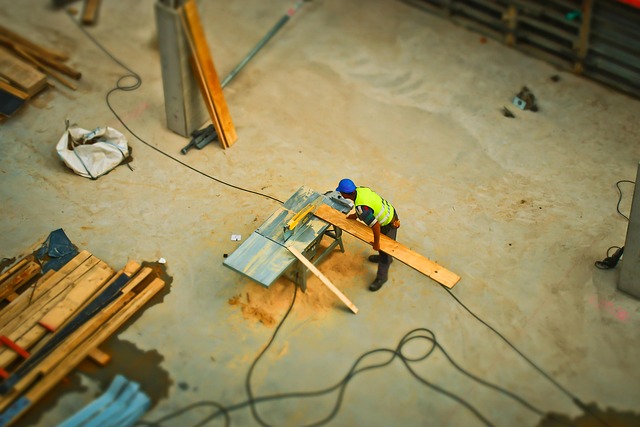Subsurface utility mapping is a critical component for efficient and safe construction planning, utilizing advanced technologies like Ground Penetrating Radar (GPR) and Radio Detection (RD) to create detailed, accurate maps of underground utilities. By integrating these maps into project management tools, fostering collaboration among stakeholders, and conducting thorough risk assessments, construction teams can minimize damage, delays, and costs, ensuring successful infrastructure planning and seamless integration with existing systems.
In the fast-paced world of construction, reliable data is the cornerstone of successful projects. This article explores the vital role of subsurface utility mapping in modern construction planning. With increasing urban development and complex underground infrastructure, accurate knowledge of buried utilities is essential for safety and project efficiency. We delve into the benefits of precise subsurface utility mapping, discuss advanced technologies for data collection and verification, and provide best practices for integrating this critical information into construction management strategies.
Understanding Subsurface Utility Mapping: The Need for Accurate Data in Construction
Utility-friendly construction relies heavily on accurate and up-to-date subsurface utility mapping data. This process involves identifying and documenting the location, type, and condition of underground utilities such as water pipes, gas lines, power cables, and sewer systems. Accurate data is crucial for avoiding costly damage during excavation and ensuring safety for workers and the public.
In today’s construction landscape, reliable subsurface utility mapping is not just a best practice but an indispensable tool. It helps project managers and contractors make informed decisions, reducing the risk of disruptions, delays, and financial losses associated with utility strikes. With the increasing complexity of urban development and the growing demand for efficient infrastructure planning, dependable data from comprehensive subsurface utility maps has become an essential component in achieving successful construction projects.
Benefits of Reliable Mapping Data for Utility Planning and Safety
Reliable mapping data is an invaluable asset for construction planning, especially when it comes to ensuring safety and efficiency, particularly in areas with extensive subsurface utilities. Subsurface utility mapping provides a comprehensive view of the underground infrastructure network, including pipes, cables, and wires. This data allows construction teams to plan routes that avoid critical utility intersections, minimizing the risk of costly and dangerous conflicts during excavation. By identifying and marking these utilities accurately, construction projects can be executed with enhanced precision, reducing damage to essential services and potential disruptions to communities.
Accurate mapping data facilitates informed decision-making, enabling project managers to optimize resource allocation and scheduling. It empowers utility companies to collaborate effectively with construction teams, ensuring that new developments integrate seamlessly with existing infrastructure. This cooperative approach enhances safety by reducing the likelihood of service interruptions or damage during construction, ultimately leading to faster project completion times and reduced costs.
Technologies and Methods for Collecting and Verifying Subsurface Utility Information
In the realm of utility-friendly construction planning, reliable data collection and verification of subsurface utilities are paramount. Advanced technologies such as Ground Penetrating Radar (GPR) and Radio Detection (RD) play a pivotal role in this process. GPR, for instance, uses electromagnetic waves to create detailed images of underground structures, enabling accurate identification of pipes, cables, and other utilities. RD, on the other hand, detects metal objects by measuring radio frequency interference, providing valuable insights into the location and depth of metallic utilities.
To ensure data integrity, cross-referencing multiple sources is essential. Combining these technologies with traditional methods like manual utility locates and historical records creates a comprehensive dataset. Verifying this information through field checks and real-time updates ensures that subsurface utility maps remain current and accurate. This multi-faceted approach to subsurface utility mapping significantly reduces the risk of damaging critical infrastructure during construction projects.
Best Practices for Integrating Mapping Data into Construction Planning and Project Management
When integrating mapping data, especially subsurface utility mapping, into construction planning and project management, several best practices stand out. Firstly, ensure that the data is accurate and up-to-date, as outdated maps can lead to costly mistakes and potential damage to underground utilities. Regularly verify and update these maps to reflect any changes in the infrastructure. Secondly, integrate mapping data seamlessly into your construction software or project management tools. This allows for efficient access and visualization during site planning and real-time updates as the project progresses.
Thirdly, involve stakeholders from all relevant departments—from engineering to site supervision—in the process of interpreting and utilizing the data. Fostering a collaborative environment ensures that everyone understands the information and can contribute to informed decision-making. Additionally, conduct thorough risk assessments based on the mapped data to anticipate potential challenges and plan mitigation strategies proactively. This proactive approach helps in minimizing delays and costs associated with utility conflicts during construction.
Reliable subsurface utility mapping is no longer a luxury but an indispensable tool for modern construction. By integrating accurate data into planning processes, construction teams can significantly enhance safety, streamline project management, and reduce costly disruptions to underground utilities. Adopting advanced technologies and best practices for collecting, verifying, and utilizing this data is essential to navigate the complexities of today’s urban landscapes, ensuring both efficient construction and reliable infrastructure.
